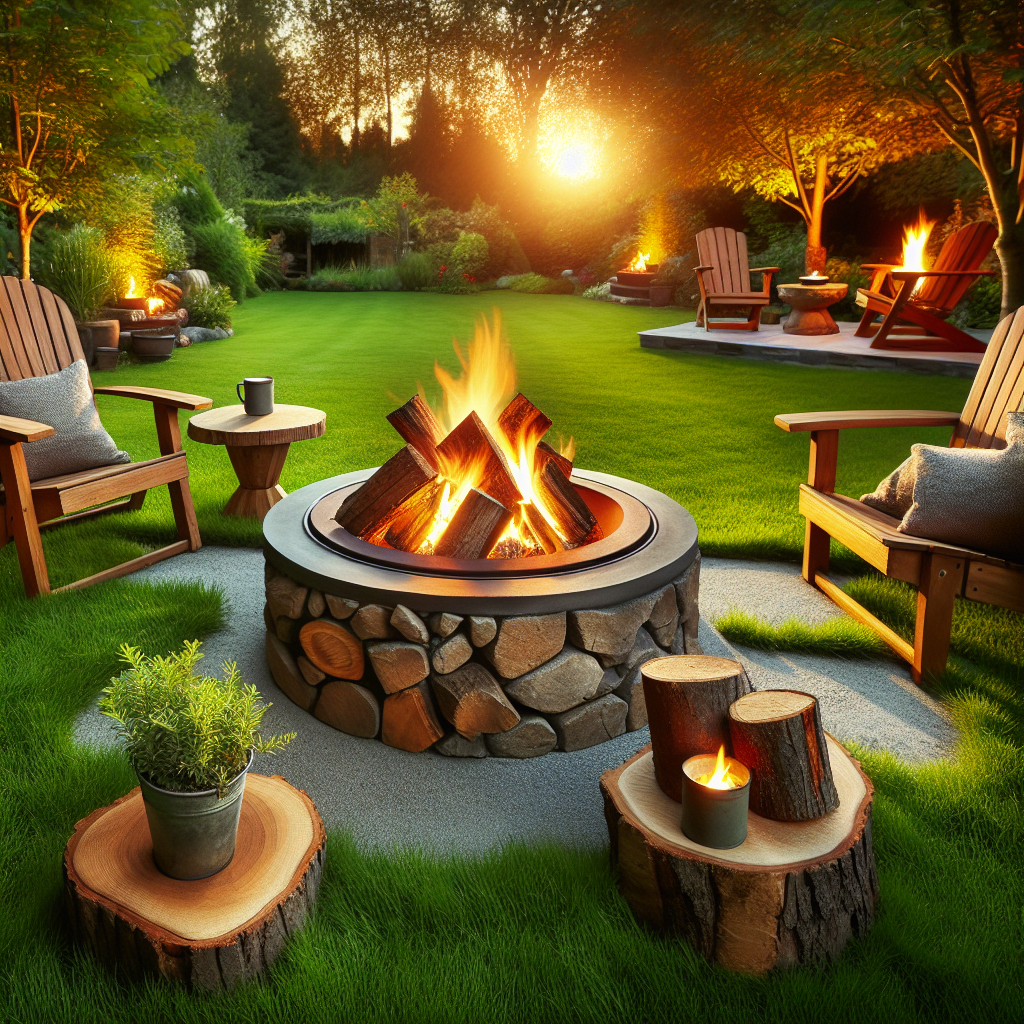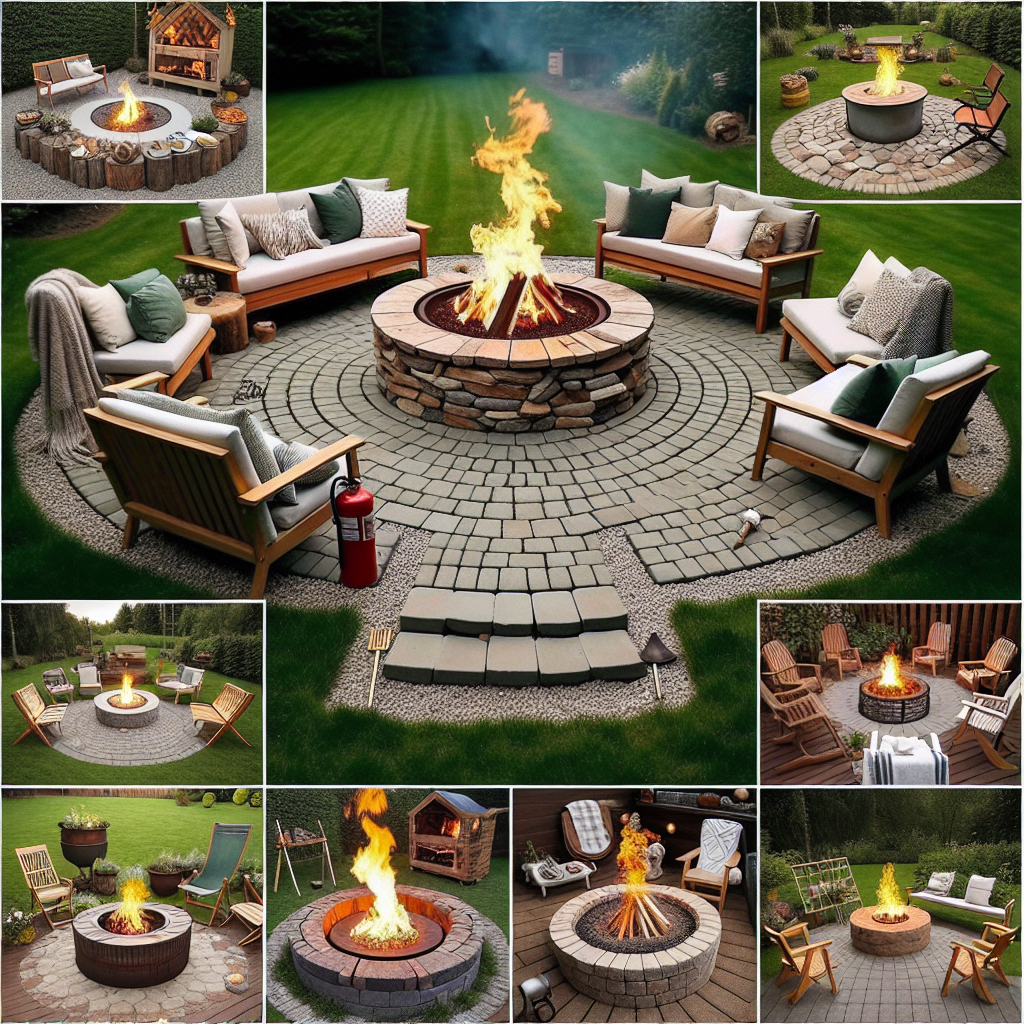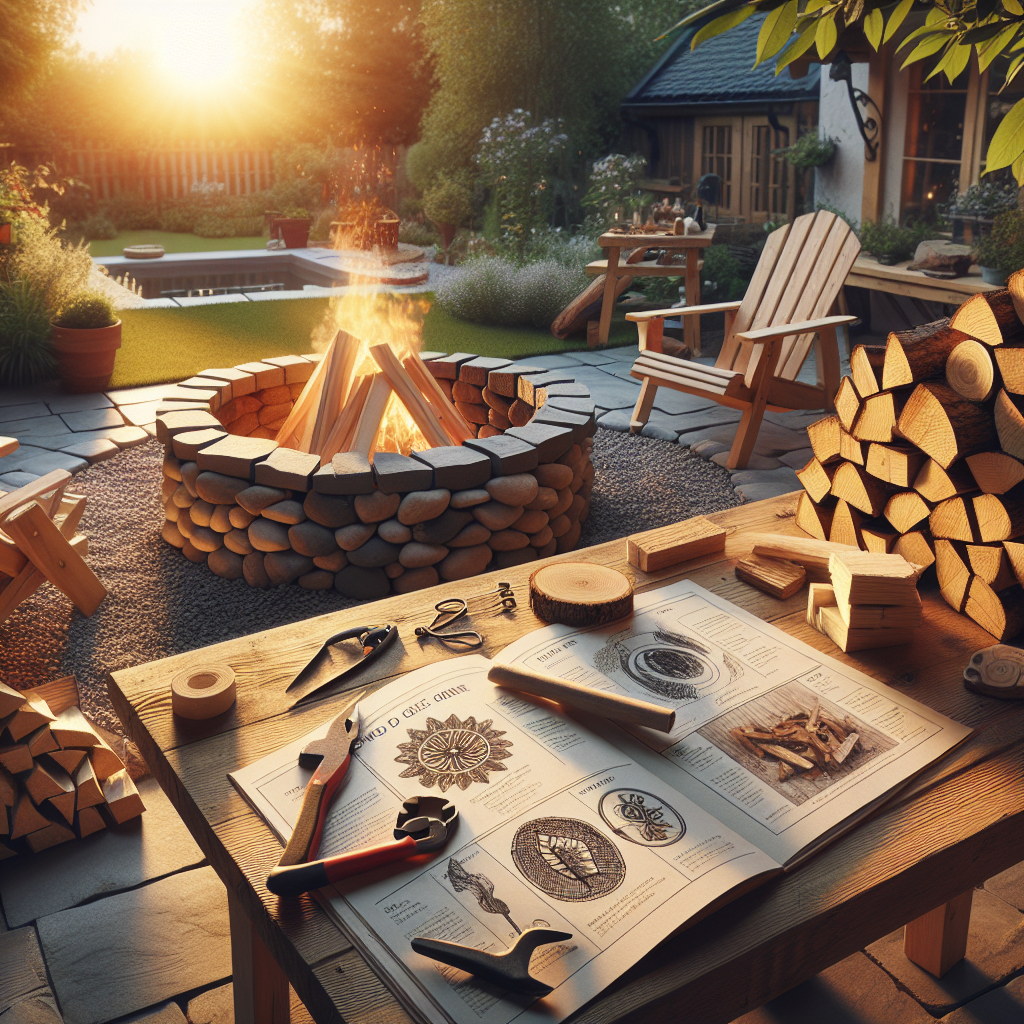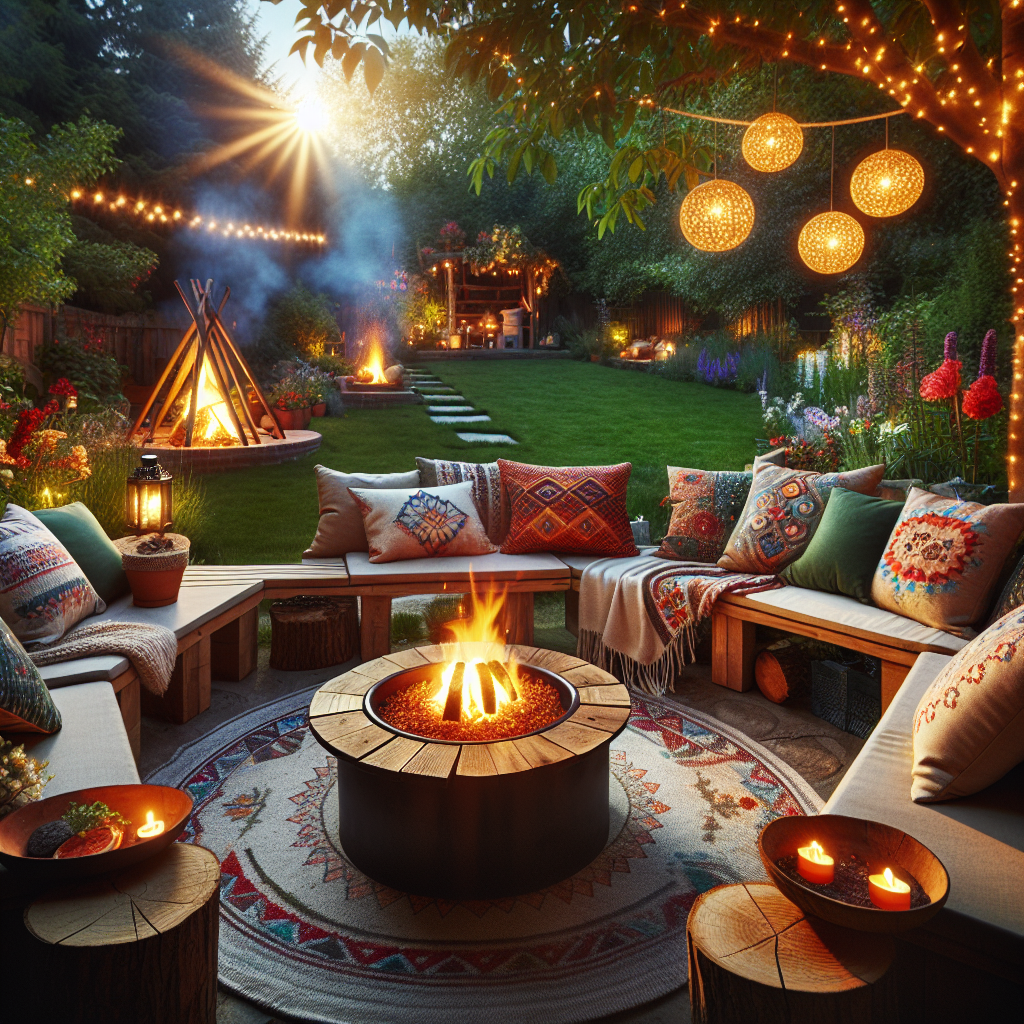Are you looking to upgrade your backyard and create a cozy outdoor space to gather with friends and family? Look no further than DIY backyard fire pit ideas! From simple and budget-friendly designs to more intricate and personalized options, there are countless ways to enhance your outdoor living space with a fire pit. In this comprehensive guide, we will explore various DIY backyard fire pit ideas that will inspire you to bring warmth and ambience to your backyard. Get ready to transform your outdoor area into a inviting oasis perfect for relaxation and entertainment.
Understanding the Basics of DIY Backyard Fire Pits

When embarking on the journey of creating a DIY backyard fire pit, it is crucial to prioritize safety considerations throughout the planning and construction process. Here are some key points to keep in mind:
- Safety Considerations for Building a Fire Pit
- Ensure the fire pit is located in an open area away from any structures, overhanging trees, or flammable materials.
- Use heat-resistant materials such as fire bricks or concrete blocks to construct the fire pit walls.
- Provide proper ventilation to prevent smoke buildup and ensure adequate airflow for the fire.
- Keep a fire extinguisher, bucket of sand, or garden hose nearby for quick access in case of emergencies.
- Different Types of Fire Pits
- Wood-Burning Fire Pits: These traditional fire pits provide a cozy ambiance and crackling sounds of a wood-burning fire. They require regular cleaning of ash and debris.
- Gas Fire Pits: Gas fire pits offer convenience and control, allowing you to adjust the flame height and intensity easily. They require a gas line or propane tank for operation.
- Propane Fire Pits: Propane fire pits are portable and versatile, running on propane tanks that can be easily replaced or refilled. They are ideal for those looking for a hassle-free fire pit option.
- Local Regulations and Permits for Fire Pit Installation
- Before starting any construction, it is essential to check local regulations and obtain any necessary permits for installing a fire pit in your backyard.
- Some areas may have specific restrictions on the type of fire pits allowed, setback requirements from property lines and structures, and regulations regarding fire pit usage.
- By adhering to local regulations and obtaining the required permits, you can ensure that your DIY fire pit is not only safe but also compliant with legal requirements in your area.
Safety First: Tips for Building a Safe Fire Pit
When it comes to constructing a DIY backyard fire pit, safety should always be the top priority. By following these essential tips, you can ensure a safe and enjoyable fire pit experience:
- Choosing the right location for your fire pit: Select a flat, level area away from any overhanging trees, structures, or flammable materials. Keep a safe distance from your home and other outdoor furniture to prevent accidental fires.
- Materials needed for constructing a fire pit: Opt for heat-resistant materials such as fire bricks, concrete blocks, or metal rings. Avoid using combustible materials that can easily catch fire or deteriorate due to heat exposure.
- Proper ventilation and fire extinguishing methods: Ensure adequate airflow around the fire pit to prevent smoke buildup and maintain a healthy fire. Keep a fire extinguisher, bucket of sand, or garden hose nearby for quick and effective fire suppression in case of emergencies. Familiarize yourself with proper fire extinguishing techniques to handle different types of fires safely.
By implementing these safety measures, you can enjoy your DIY backyard fire pit while minimizing the risk of accidents or property damage.
Types of Fire Pits: Pros and Cons
Understanding the Basics of DIY Backyard Fire Pits
When considering the types of fire pits for your backyard, it’s essential to weigh the pros and cons of each option to determine which best suits your needs and preferences.
- Wood-Burning Fire Pits
Wood-burning fire pits offer a traditional and rustic charm that many homeowners find appealing. The crackling sound of burning wood and the mesmerizing flames create a cozy atmosphere perfect for gatherings. However, these fire pits require regular maintenance, including cleaning out ash and ensuring a good supply of firewood. Additionally, there’s the need to consider safety precautions and local regulations regarding open flames.
- Gas Fire Pits
Gas fire pits have gained popularity for their convenience and cleanliness. They are easy to ignite with a simple turn of a knob, providing instant warmth and ambiance without the hassle of dealing with wood. Gas fire pits also produce less smoke and sparks, making them a safer option, especially in areas prone to fire hazards. However, the installation of a gas line may require professional assistance, adding to the overall cost.
- Propane Fire Pits
Propane fire pits are a portable and user-friendly alternative to traditional wood-burning fire pits. They offer the convenience of being able to move the fire pit to different locations within the backyard or even take it on camping trips. Propane fire pits are relatively easy to set up and operate, usually requiring a propane tank that can be easily replaced when empty. However, ongoing costs related to propane refills should be factored into the decision-making process.

Design Inspiration for DIY Backyard Fire Pits
When considering the design of a DIY backyard fire pit, it’s essential to think about how it will fit into your outdoor space. The placement of the fire pit can create a cozy ambiance and serve as a focal point for gatherings with family and friends.
Creative Fire Pit Designs
- Circular Fire Pits: Circular fire pits offer a classic and symmetrical look. They can be built using bricks, pavers, or even metal rings for a modern touch. Circular fire pits encourage conversation as people can gather around the fire from all sides.
- Square Fire Pits: Square fire pits provide a more contemporary and structured appearance. They can be constructed with retaining wall blocks for a clean and uniform look. Square fire pits work well in modern outdoor settings and can easily be integrated into existing patio spaces.
- Sunken Fire Pits: Sunken fire pits are a great way to create a cozy and intimate atmosphere. By lowering the fire pit into the ground, you can achieve a more secluded and private setting. Sunken fire pits can be lined with stone or metal for a stylish finish.
- Raised Fire Pits: Raised fire pits elevate the fire area, making it a prominent feature in your backyard. They can be constructed using stone, bricks, or even concrete blocks. Raised fire pits offer a unique design element and can also act as a functional outdoor table when not in use.
Adding Seating Options
In addition to the design of the fire pit itself, incorporating comfortable seating around the fire pit area is crucial for creating a welcoming outdoor space. Consider adding built-in benches, Adirondack chairs, or even outdoor sofas to provide ample seating for guests. Adding cushions, pillows, and blankets can enhance the coziness and encourage relaxation around the fire pit.
Integrating the Fire Pit into Your Outdoor Space
When it comes to integrating a DIY fire pit into your outdoor space, there are several key factors to consider to ensure a seamless and cohesive design. Here are some essential tips to help you make the most of your backyard fire pit area:
- Enhancing ambiance with lighting and landscaping
- Incorporate ambient lighting around the fire pit area to create a warm and inviting atmosphere during evening gatherings.
- Consider using string lights, lanterns, or solar-powered fixtures to add a touch of magic to the space.
- Utilize landscaping elements such as strategically placed plants, shrubs, or decorative rocks to frame the fire pit and enhance its visual appeal.
- Choosing complementary outdoor furniture for the fire pit area
- Select outdoor furniture pieces that complement the style and size of your fire pit.
- Opt for comfortable seating options like outdoor sofas, chairs, or benches that encourage relaxation and socializing around the fire.
- Ensure that the furniture is weather-resistant and durable to withstand outdoor elements and frequent use.
- Creating a cozy atmosphere with blankets and pillows
- Enhance the comfort and coziness of your fire pit area by adding soft blankets and cushions to the seating area.
- Choose fabrics that are both stylish and functional, such as weatherproof materials that can withstand moisture and dirt.
- Incorporate blankets in warm hues or soft textures to encourage guests to linger around the fire pit and enjoy the ambiance.
Creative Designs for DIY Fire Pits
When it comes to designing a DIY fire pit for your backyard, the options are virtually endless. Here are some creative designs to inspire your outdoor space:
- Circular fire pit with seating wall: A circular fire pit surrounded by a seating wall offers a cozy and intimate setting for gathering with friends and family. This design not only provides ample seating but also creates a focal point in your backyard.
- Square fire pit with built-in grill: For those who love to cook outdoors, a square fire pit with a built-in grill is the perfect combination of functionality and aesthetics. This design allows you to enjoy the warmth of a fire while also being able to grill your favorite foods right beside it.
- Sunken fire pit with surrounding greenery: Creating a sunken fire pit with surrounding greenery adds a touch of natural beauty to your outdoor space. By incorporating plants and flowers around the fire pit, you can enhance the ambiance and create a tranquil oasis in your backyard.
Budget-Friendly DIY Fire Pit Ideas
When it comes to creating a cozy outdoor space without breaking the bank, opting for budget-friendly DIY fire pit ideas can be a rewarding endeavor. By repurposing materials and making strategic choices, you can enjoy the warmth and ambiance of a fire pit without a hefty price tag. Here are some tips to help you get started:
- Repurposing Materials for a Cost-Effective Fire Pit
Repurposing materials is a creative and environmentally friendly way to build a fire pit on a budget. Look around your property or visit local salvage yards to find items like old bricks, paving stones, or even a metal drum that can be transformed into a unique fire pit. With a little ingenuity and elbow grease, you can repurpose these materials into a functional and stylish fire feature. - DIY Fire Pit Kits vs. Custom-Built Fire Pits
When considering budget-friendly options for a DIY fire pit, it’s essential to weigh the pros and cons of using a DIY fire pit kit versus building a custom fire pit from scratch. DIY fire pit kits typically come with all the necessary components and instructions, making the assembly process more straightforward. However, custom-built fire pits allow for greater customization and creativity, albeit with potentially higher costs. Depending on your budget and skill level, choose the option that best suits your needs. - Shopping Smart for Affordable Fire Pit Supplies
To keep costs down when building a DIY fire pit, it’s essential to shop smart for affordable supplies. Compare prices at different home improvement stores, online retailers, and local marketplaces to find the best deals on fire pit essentials such as fire bricks, gravel, and a fire ring. Additionally, consider seasonal sales, clearance items, and DIY discounts to maximize your savings without compromising on quality. By being strategic and resourceful in your shopping, you can create a budget-friendly fire pit that enhances your outdoor space.
Repurposing Materials for a Unique Fire Pit
Repurposing materials for a unique fire pit can not only add character to your backyard but also help minimize waste and reduce costs. Here are some creative ideas for repurposing materials to create a one-of-a-kind fire pit:
- Using old bricks or stones for a rustic fire pit: Old bricks or stones can be stacked or arranged in a circular pattern to form the walls of a traditional and rustic fire pit. These weathered materials add a charming and timeless look to your outdoor space, creating a cozy atmosphere for gatherings around the fire.
- Upcycling a metal drum into a fire pit: Transforming a discarded metal drum into a fire pit is a sustainable and budget-friendly option. By cutting an opening in the drum and adding a grate or mesh to contain the fire, you can repurpose this industrial object into a functional and stylish fire feature. The circular shape of the drum allows for a 360-degree view of the flames, enhancing the ambiance of your backyard.
- Incorporating recycled glass or pebbles for a modern touch: For a contemporary and eco-friendly fire pit design, consider using recycled glass or colorful pebbles as a decorative element. These materials can be placed in the bottom of the fire pit to cover the ground and reflect the flames, creating a visually striking effect. The combination of fire and glass or pebbles adds a touch of sophistication to your outdoor space, making it a focal point for outdoor entertaining.
Making the Most of DIY Fire Pit Kits
When it comes to creating a budget-friendly and visually appealing fire pit in your backyard, utilizing a DIY fire pit kit can be a game-changer. These kits offer a convenient way to assemble a fire pit without the need for extensive masonry skills or specialized tools. Here are some key details to consider when making the most of DIY fire pit kits:
- Benefits of Pre-Packaged Fire Pit Kits:
- DIY fire pit kits typically come with all the necessary components, such as a fire ring, blocks, and a metal liner, making the assembly process straightforward and hassle-free.
- These kits often include step-by-step instructions that are easy to follow, ensuring that even beginners can successfully build a fire pit in a short amount of time.
- By opting for a pre-packaged kit, you can save both time and money compared to purchasing individual materials and designing a fire pit from scratch.
- Customizing a Kit to Fit Your Backyard Aesthetic:
- One of the advantages of DIY fire pit kits is the flexibility they offer in terms of customization. You can choose from a variety of materials, shapes, and sizes to match your backyard’s design theme.
- Consider adding decorative elements such as colored stones, mosaic tiles, or a built-in seating area to personalize your fire pit and create a unique outdoor gathering space.
- Some kits even allow for additional features like grilling surfaces or adjustable height settings, giving you the freedom to tailor your fire pit to suit your specific preferences.
- Installation Tips for DIY Fire Pit Kits:
- Before starting the assembly process, ensure that you have a level foundation for the fire pit to sit on. This will help prevent shifting or instability once the fire pit is in use.
- Follow the manufacturer’s instructions carefully when placing the blocks or stones to create a sturdy and durable structure. Pay attention to proper alignment and spacing to achieve a professional-looking result.
- Once the fire pit is assembled, test it with a small fire to ensure that it functions safely and effectively. Make any necessary adjustments before using it for larger gatherings or extended periods.

By leveraging the benefits of DIY fire pit kits and incorporating your own creative touches, you can transform your backyard into a welcoming and cozy outdoor retreat that is perfect for entertaining or relaxing evenings spent by the fire.
Maintenance and Upkeep of DIY Backyard Fire Pits
When it comes to maintaining and caring for your DIY backyard fire pit, there are several key aspects to consider to ensure its longevity and safe use.
Cleaning and Maintaining Your Fire Pit
Regular cleaning of your fire pit is essential to prevent the buildup of ash, debris, and soot that can affect its functionality and aesthetics. Here are some steps to effectively clean and maintain your DIY fire pit:
- Remove Ash and Debris: After each use, make sure to remove any remaining ash and debris from the fire pit using a shovel or ash tool. This not only prevents blockages but also helps in maintaining good airflow for a consistent flame.
- Scrubbing the Fire Pit: Periodically scrub the interior and exterior of the fire pit with a stiff brush and mild detergent to remove stubborn residue and maintain its appearance. Rinse thoroughly and allow it to dry completely before using it again.
- Inspecting for Damage: Regularly inspect the fire pit for any signs of damage such as cracks, rust, or wear. Addressing these issues promptly can prevent further deterioration and ensure the safety of your fire pit.
Protecting the Fire Pit from the Elements
Shielding your DIY fire pit from the elements can significantly extend its lifespan and preserve its functionality. Consider the following tips for protecting your fire pit:
- Covering When Not in Use: Invest in a weatherproof cover or tarp to protect your fire pit from rain, snow, and other harsh weather conditions when it is not in use. This simple step can prevent rust and corrosion, especially for metal fire pits.
- Storing Properly: If you live in an area with extreme weather conditions, consider storing your fire pit in a dry and sheltered location during the off-season to prevent damage and prolong its usability.
Troubleshooting Common Fire Pit Issues
Despite regular maintenance, fire pits may encounter common issues that require troubleshooting to ensure optimal performance. Here are some common problems and their solutions:
- Uneven Burning: If your fire pit is burning unevenly, check for obstructions in the burner holes or gas line and clean them if necessary. Adjusting the gas pressure or positioning of the logs can also help achieve a more even flame.
- Smoke Emission: Excessive smoke emission can be due to poor airflow or improper fuel combustion. Ensure proper ventilation around the fire pit and use seasoned firewood to minimize smoke production.
- Gas Fire Pit Ignition Problems: If your gas fire pit is having ignition issues, check the fuel supply, ignition system, and ensure all connections are secure. Consult the manufacturer’s manual for specific troubleshooting steps.
By following these maintenance and upkeep tips, you can enjoy a safe, efficient, and aesthetically pleasing DIY backyard fire pit for years to come.
Essential Maintenance Tasks for Fire Pit Longevity
- Regularly removing ash and debris from the fire pit: One of the key maintenance tasks for ensuring the longevity of your DIY backyard fire pit is to routinely clean out accumulated ash and debris. Ash buildup can not only affect the aesthetics of your fire pit but can also lead to corrosion of the materials over time. By cleaning out the ash regularly, you prevent these issues and maintain the functionality and appearance of your fire pit.
- Sealing and protecting the fire pit materials: To prolong the life of your DIY fire pit, it’s essential to seal and protect the materials used in its construction. Depending on the type of fire pit you have, whether it’s made of metal, stone, or brick, applying a suitable sealant can help prevent rust, erosion, or discoloration caused by exposure to the elements. By taking the time to seal and protect the materials, you not only maintain the visual appeal of your fire pit but also ensure its structural integrity over the long term.
- Inspecting gas lines and connections for safety: For those with gas-powered fire pits, regular inspection of the gas lines and connections is paramount for safety and longevity. Gas leaks can be not only hazardous but can also damage the components of your fire pit. Checking for any signs of wear and tear, ensuring proper fittings, and testing for leaks are crucial maintenance tasks to preserve the functionality and safety of your gas fire pit. Regular inspections can help identify and address any issues before they escalate, ultimately extending the lifespan of your DIY backyard fire feature.
Troubleshooting Common Fire Pit Problems
When it comes to maintaining DIY backyard fire pits, troubleshooting common issues promptly can ensure the longevity and safety of your outdoor fire feature. Here are some key problems to watch out for and how to address them effectively:
- Issues with gas flow in gas fire pits
Gas fire pits can sometimes experience issues with gas flow, leading to irregular flames or difficulty igniting the fire. To troubleshoot this problem, first, check the gas supply line for any blockages or leaks. Ensure that the gas valve is fully open and that the connections are secure. If the issue persists, consider cleaning the gas burner or consulting a professional for further inspection.
- Cracks or damage to the fire pit structure
Over time, the structural integrity of a fire pit can be compromised due to exposure to high temperatures and weather elements. If you notice cracks or damage to the fire pit structure, it is essential to address these issues promptly to prevent any safety hazards. Depending on the material of your fire pit, such as stone, brick, or metal, you may need to repair the cracks using appropriate sealants or replacement parts.
- Dealing with rust or corrosion on metal fire pits
Metal fire pits are susceptible to rust and corrosion, especially if they are exposed to moisture and humidity. To tackle this issue, start by cleaning the affected areas with a wire brush to remove the rust buildup. Once the surface is clean, apply a high-temperature paint or rust-resistant coating to protect the metal from further corrosion. Regular maintenance, such as keeping the fire pit covered when not in use and applying a protective sealant, can help prevent rust formation in the future.
FAQs for DIY Backyard Fire Pit Ideas
What are some creative DIY backyard fire pit ideas?
There are endless possibilities when it comes to creating a DIY backyard fire pit. Some popular ideas include using old bricks or stones to construct a rustic fire pit, repurposing an old washing machine drum as a modern fire pit, or even turning a simple clay flower pot into a mini fire pit for smaller spaces. Get creative and think outside the box to personalize your backyard fire pit.
How can I ensure the safety of my DIY backyard fire pit?
Safety should always be a top priority when it comes to operating a fire pit in your backyard. Make sure to keep your fire pit at a safe distance from any flammable materials, such as trees or shrubs. Always have a source of water nearby to extinguish the fire if necessary. Additionally, consider investing in a spark screen or grate to prevent flying embers from causing any accidents.
Are there budget-friendly DIY backyard fire pit ideas?
Yes, there are plenty of budget-friendly DIY backyard fire pit ideas that can be created using inexpensive materials. For example, you can gather rocks or stones from your backyard or local park to construct a simple fire pit. Alternatively, you can repurpose old metal barrels or bricks to create a unique and affordable fire pit. The key is to get creative and resourceful when designing your backyard fire pit.
How can I make my DIY backyard fire pit more aesthetically pleasing?
There are several ways to enhance the aesthetics of your DIY backyard fire pit. Consider adding decorative elements, such as mosaic tiles or colorful glass beads, to the fire pit’s design. You can also surround the fire pit with comfortable seating and outdoor lighting to create a cozy and inviting atmosphere. Don’t be afraid to experiment with different materials and styles to personalize your backyard fire pit and make it a focal point of your outdoor space.
